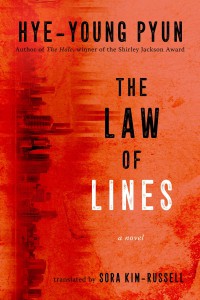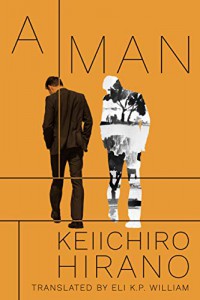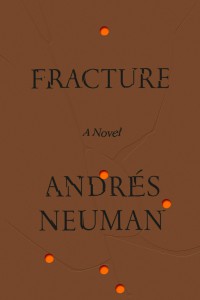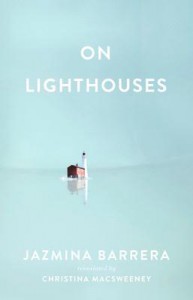The best that literature has to offer us is not resolution, but that Barthian sentiment of recognition—the nakedly exact internal sentiment rescued from wordlessness and placed in a social reality. In this month’s selections of translated works, the authors confront a myriad of trials and ideas—despair, rage, guilt, purpose, obsolescence—with stories that attest equally to the universality of human feelings and the precise specificities of localities. Read reviews of four spectacular texts from Japan, Korea, Spain, and Mexico now:

The Law of Lines by Hye-Young Pyun, translated from the Korean by Sora Kim-Russell, Arcade Publishing, 2020
Review by Marina Dora Martino, Assistant Editor
How does the world change us? Is it life and its unpredictable events that bend us; or is it something more fundamental, something that has always been hatching inside ourselves, ready to ripen at the right occasion? These questions act as the fundamental hinges of The Law of Lines, a novel written by South Korean author Hye-Young Pyun and translated by Sora Kim-Russell. Although ambitious and abstract, these existential questions acquire here a concrete form—they are investigated—not by philosophical or religious means—through the stories of two young women, Se-oh and Ki-jeong. Set in the vast South Korean suburban world, The Law of Lines travels through injustice, poverty, and grief, and exposes the thin threads that run between people who didn’t even know they were connected.
Ki-jeong is a teacher. She doesn’t like teaching—actually, she hates it. To get through her day, Ki-jeong transforms her life into a performance, and herself into a mere act of herself. Only in this way she manages, with varying degrees of success, to hide her frustration, her disengagement, and her lack of empathy for the people around her. Se-oh is a young woman who lives as a semi-recluse at her father’s house. She doesn’t go out because she fears the world, that churning machine that ruins and distorts everything. Ki-jeong and Se-oh don’t have dreams of a better life, or not exactly. They are dormant and static. But their stillness is not only a desire for tranquillity—it’s a method for concealment.
Soon, the world presents them with irreversible and unpredictable events, and their apparently quiet lives break irrevocably. In the middle of a stressful day at school, Ki-jeong receives a mysterious phone call that throws her on a desperate search for the truth. Her half-sister, the one Ki-jeong and her mother had never managed to really love, becomes her only thought and anchor to reality. Se-oh is almost home after one of her rare trips to the stores when she is startled by the view of her house enveloped by fire. She sees the paramedics carrying away a man on a barrel, and from then on, her life turns into a quest—to track down and plan the destruction of the man she blames for everything that went wrong.
“The things a person said and did had a way of ruining them little by little.” If at the beginning Su-oh—the man Se-oh is following and the object of her obsession—was a decent man, his job has degraded him little by little. Now, walking silently but gracelessly, and spitting on the pavements at crossroads, he’s not the same man as when he started at the company of debt collectors a few years before. No one is safe from the world’s constant, inexorable erosion. Not even Ki-jeong, who wanted to prove to her mother her identity as a paragon of diligence and seriousness, unlike her enigmatic sister. Not even Se-oh, who had tried to atone for her past life’s mistakes through her seclusion. The polarity between those who suffer and those who inflict suffering dissolves under the caustic action of misery.
Although Ki-jeong and Se-oh are at the very heart of The Law of Lines, the narrator’s point of view oscillates between characters with freedom, which at times seemed confusing and at others purposeful. The narration, always in third person, moves through the protagonists with ease, then jerks unexpectedly and enters the conscience of secondary characters for a brief time—a police officer, the debt collector Su-oh, and the owner of a small shop. This fluctuation between points of view pushes the boundary between “good” and “bad” even further. “Bad thoughts were pungent, like garlic or ginger. Once the smell was on you, you couldn’t hide it,” observes again the narrator. Is there a punishing, inescapable morality underneath the surface of the narration, one in which bad thoughts are not transient expressions of one’s conscience, but indelible marks, to the point that they even emit a smell, like rot? Or is morality absent altogether, and nobody can be said innocent or guilty?
Translator Sora Kim-Russell (whose translation of the short story Happy Family, by Koh Jongsok, was published in the Spring 2018 issue of Asymptote), renders the text in a colloquial, clear English, whose oddness of phrasing enhances the story’s eeriness. The tone is direct, and only occasionally has led me to wonder—maybe purposefully—how much the narrator knows compared to the characters, and when and why the shift between one and the other happens. The language is confident, but it also reflects Ki-jeong and Se-oh’s vulnerability and the doubts, barely visible and ghost-like, haunting their lives. The Law of Lines is a tale of loss and estrangement that promises no relief; in its world there might not be absolute evil, but you won’t find absolute redemption either.

A Man by Keiichiro Hirano, translated from the Japanese by Eli K. P. William, Amazon Crossing, 2020
Review by Samuel Miller, Chief Executive Assistant
To the anglophone audience, Japanese fiction must seem like a monolith thanks entirely to the hegemonic influence of a select few powerhouse writers who dominate the scene. For the first few chapters of Keiichiro Hirano’s A Man, I too found myself unwittingly making comparisons to existing works by better-known names, but the more I read, the faster those comparisons dissipated. By the end of the book, I had to chalk any similarities up to the nature of the text’s native language; A Man, beautifully translated by Eli K.P. William, can stand proudly on its own two feet as an excellent, meditative work.
Other reviews have mentioned the similarities to Raymond Chandler, though this book reminded me far more of a silver-screen noir adaptation from Hollywood’s golden age than Chandler’s actual written works; it’s every inch a modern noir mystery. The main protagonist is Akira Kido, a lawyer hired by a former client to find out the true identity of her dead husband who she learns had been living with her under an assumed identity. Kido is a contemporary evolution of the hard-bitten, hard-drinking P.I. Just as with Chandler’s Phillip Marlowe, alcohol plays an explicit role throughout the story, including one pivotal scene involving vodka gimlets, a nod to Marlowe’s preferred cocktail made with Kido’s preferred spirit.
Kido isn’t so much a tortured character as he is a modern one. While unravelling the mystery of Mr. X, he is simultaneously dealing with the myriad emotions of first time fatherhood, a rocky marriage, the recent trauma of the 2011 earthquake, and the constant feeling of discrimination as a Zainichi, an ethnic Korean. His contemplative inner monologue makes up much of the book, and it’s through him, as well as Rié, wife of dead Mr. X, that the author works out questions of identity, truth, and fate.
The narrative is sparse, like most translated Japanese fiction I’ve read, but this is by no means a negative. The dialogue and narrations are delicate and thoughtful; environments, from an ancient, cherry tree-studded cemetery, to the dark, snowy alleyways of Tokyo, are atmospheric and beautifully rendered. There is a lack of superfluous description or dialogue—the best way I can describe the feeling of reading this book is that it evokes a sense of quiet, encouraging the reader to slow down, to digest everything.
This calm is important, because the sheer scope of the philosophical problems Hirano tackles could very easily have felt overwhelming. There are no easy answers or tidy bows here. Instead, Hirano embraces the reality that life is complicated, and that we don’t get to chose the hand we are dealt. History, racism, memory, love, lust, trauma, untimely death . . . These are all things that we face everyday, and Hirano confronts them head on, thinking his way through them, creating a refreshingly complex and highly realistic world.
By and large, William’s translation is excellent, with sophisticated prose that beautifully enhances the minimalist lyrical qualities of the text. So it’s particularly jarring when a stray bit of jargon (eg. “riding shotgun,” “normcore,” “schmaltzy” etc.) interrupts the sentence. But aside from the oddly placed slang word, the translation does an excellent job of creating a world that allows the reader to quietly immerse themselves in the contemplations of the characters.
As the title suggests, A Man is ultimately a query into what makes up a person. It wrestles with the old nature vs. nurture question and ends up, like the other philosophical questions in the story, with a complex answer. The investigation into the identity of Rié’s dead husband is really an investigation of identity itself, exploring whether it’s even possible to really know another person. While we can know a great deal about a person through their life story, circumstances, and actions, these perceptions are really only skin deep.
After all, there was no way to know the ‘true past’ of another. Unless they were right in front of you, there wasn’t even any way to know what someone was doing or where they were in the present. In fact, it might very well be hubris to believe that you could understand a person’s true thoughts and feelings even when looking straight at them.
In this world, characters are able to switch into another’s life with a quick bit of identity fraud, sometimes even doing so multiple times. As the story unravels, Kido and Rié find themselves wondering how it is possible for some people to live another’s life more successfully than its original occupant, while others are dragged down by their assumed identity’s previous baggage. These questions of what is innate to us, what is circumstantial, and how the two affect who we are over the course of a lifetime, run the length of the book.
In the end, there isn’t a clear answer to these questions and, to be honest, I prefer it that way. This doesn’t feel at all like a cop-out; Hirano does due diligence on the long journey of investigation we take with Kido and Rié. But it is Rié, the book’s most tragic character, who reveals A Man’s one, poetic certainty—death.
A life is something that you can exchange with someone else—Rié would never have dreamed such a thing if her husband hadn’t demonstrated it was true. He had actually led the life of another. But what about death? Death, she felt certain, was the only thing you could never exchange with anyone.
Hirano isn’t shying away from complicated problems; on the contrary, complexity is his answer. He spends the entire novel confronting identity in the real world, before laying out the results of his findings and concluding that there just isn’t a clean answer. Life is messy, people are messy; he doesn’t try to simplify that fact, and his story is all the better for it.

Fracture by Andrés Neuman, translated from the Spanish by Nick Caistor and Lorenza Garcia, Farrar, Straus and Giroux, 2020
Review by Edwin Alanís-García, Assistant Editor
. . . very soon there won’t be a single person on the face of the earth who was there. When that happens, Hiroshima and Nagasaki will only be broken things that no one saw break. How dreadful, he thought. How wonderful.
An interesting fact I learned from Andrés Neuman’s extraordinary new novel, Fracture: the word “catastrophe” acquired its current meaning from an earthquake in Lisbon (presumably the Great Lisbon Earthquake of 1755). Prior to this disaster, the term generally referred to the denouement of a dramatic work. Asides like these are scattered throughout this novel, providing fragments of the narrators’ shared recollections, pieces of a storied puzzle about how we make sense of public (and private) disasters. Spanning four continents and seven decades, Fracture is a masterfully written novel about brokenness and the possibility of repair—even when such repair is itself a constant reminder of brokenness.
Our protagonist is Yoshie Watanabe (an apparent nod to Japanese-Peruvian poet José Watanabe, who is quoted in the epigraph), a survivor of the atomic bombing of Hiroshima. The novel begins in modern-day Tokyo, where Mr. Watanabe finds himself once again surviving catastrophe when the most powerful earthquake in Japan’s history strikes the islands, with the resulting tsunami leading to the meltdowns of several reactors in the Fukushima Daiichi Nuclear Power Plant. In the disaster’s aftermath, he’s hounded by a persistent (or perhaps obsessive) Argentinian journalist named Jorge Pinedo, who seems more fascinated by Watanabe’s life story than he is with the Fukushima disaster. Unable to get the story he wants, Pinedo reaches out to four of Watanabe’s past lovers, who offer first-person accounts of their lives—as well as their memories and impressions of Yoshie. The alternating points of view provide a narrative structure that jumps between observer and observed, helping Pinedo piece together the mystery of Yoshie Watanabe’s life.
Neuman’s control of voice makes the interview chapters among the most memorable: there’s Violet, a Parisian college student; Lorrie, a socially progressive journalist from New York; Mariela from Buenos Aires, who finds kinship with Yoshie in light of her memories of Argentina’s Dirty War; and Carmen, a retiree from Madrid still haunted by the death of her husband. Between these engrossing character studies, we follow Watanabe’s journey to the Fukushima Prefecture and witness its desolation. Through horrifying flashbacks we’re shown Watanabe’s memories of the bombs that scarred his body and killed his family. Nevertheless, Yoshie maintains composure and joviality with Lorrie’s hawkish conservative brother, an unapologetic defender of the attack. Such displays of mended wounds belie a trauma that persists as Watanabe seeks out the site of a new nuclear catastrophe.
In engaging cultural attitudes about the bombing, Neuman flouts the (I’d say false) dichotomy between the personal and the political. We can read Fracture as a commentary on how state-controlled media influences cultural attitudes, e.g., how the American bombings of Hiroshima and Nagasaki can be propagandized as a natural disasters instead of state terrorism, or how the Japanese government and media attempts to downplay the Fukushima meltdowns. But we can also read Fracture as the life of one lonely outsider who struggles across languages and borders to connect with the women who have loved him over the decades.
In contrast to Neuman’s equally brilliant English-language debut, the philosophical novel Traveler of the Century, Fracture eschews Pynchonian maximalism for a more introspective character study. Though comparisons to Bolaño are inevitable (Bolaño himself was an ardent champion of Neuman’s writing), Fracture feels far more modern than postmodern, and is particularly Woolfian in its character depth and ambitious narrative structure. Historical bits of information orbit the themes of language, war, censorship, and loss, yet the keyword in Neuman’s novel is the title itself—fracture. Earthquakes roil the earth as if it were liquid. Fractures are visible in the buildings of Buenos Aires. Life, work, and powers outside their control fracture the relationships of the protagonists. And of course there’s the aesthetic of kintsugi, the Japanese art that mends broken pottery with precious metals, a symbolic fixation for Watanabe who is himself broken and repaired across many iterations and national identities. Likewise, the alternating points-of-view foreground a fracture in our protagonist’s identity that hearkens to Woolf’s Mrs. (Clarissa) Dalloway. In the first-person chapters, he is Yoshie. In the reflective and stoic third-person chapters, he is Mr. Watanabe. His identity is constructed for Pinedo by those who knew him (there’s shades of Woolf’s Jacob Flanders in this technique), but only insofar as the reserved and lonely survivor starts a new life wherever his career takes him—ultimately leading him back home to a new ground zero. On his drive south through Japan, Watanabe sees a sign that reads: YO-NO-MORI. It takes him a moment to realize the sign points to Yonomori Park in the Fukushima Prefecture. Here is just one example of Neuman’s brilliance and importance as an international writer, demonstrating the linguistic virtuosity Bolaño no doubt recognized in the young novelist—Mr. Watanabe, having lived so many years in Hispanophone countries, instinctively reads the sign in Spanish: I didn’t die.

On Lighthouses by Jazmina Barrera, translated from the Spanish by Christina MacSweeney, Two Lines Press, 2020
Review by Arabella Bosworth, Blog Copyeditor
In Jazmina Barrera’s slim but beautiful meditation on lighthouses, we are introduced to six lighthouses in—as you might expect—isolated locations: all except for a “little red lighthouse”—Jeffrey’s Hook, tucked away under George Washington Bridge in New York. Dwarfed by its steel companion, and with its conical red form tipped with green, it has “the appearance of a toy”—an impression cemented by its starring role in a 1940s illustrated children’s book by Hildegarde Swift. In a charming—if a little quaint—tale, Barrera tells of how, when the authorities decided to sell the obsolete lighthouse, “the children who had read The Little Red Lighthouse and the Great Gray Bridge protested,” leading to the cancellation of the auction.
If Jeffrey’s Hook’s geography is unusual in On Lighthouses, its rendering by Barrera is characteristic of her intimate, idiosyncratic narrative essay. Literary references, memoir, historical anecdotes, philosophical musings, etymological asides, and scientific detail swirl together to create an impression that is both nostalgic and clear-eyed, poetic, and informative. Loosely structured around Barrera’s visits to different lighthouses, and interspersed with—if not driven by—her reading around the subject, On Lighthouses is just as concerned by the mechanical workings of lighthouses (each chapter opens with the coordinates and basic description of the lighthouse and its beam—“single flash every three seconds”—or foghorn—“two-second blast every fifteen seconds”) as it is by the symbolism that surrounds them: as concerned by the act of collecting lighthouses as the lighthouses themselves. In its ability to glide between different prose styles, her writing is liminal, similar to the structure it describes, on the border of land and water; between modernity and obsoletion; function and symbol.
Barrera lives in New York, an island so crowded by tall, metal structures that none can serve as “a point of orientation.” It is from the confines of her gloomy fifth-floor apartment (“looking up, you can’t see the sky”) that she tells of an unfurling obsession with visiting lighthouses; of great marine expanses and tall, narrow interiors; of the people who have written about these unmoving objects and the people who have lived and worked in them. Most of all, she writes of what it might mean to be drawn to these inherently—if almost archaically—functional yet enigmatic buildings, the allure of a bleak, deliberate solitude. Solitude, as distinguished from loneliness, stands at the heart of this book. In a particularly frank section, Barrera declares:
I’d like to become a lighthouse: cold, unfeeling, solid, indifferent. When I see them, I sometimes have the sense that I really could turn to stone, and enjoy the absolute peace of rock.
There is an undeniable melancholy in much of the text, a search for meaning in obsession, in collecting, in writing; but there is a hopeful wonder too, and a calm joy. Translator Christina MacSweeney beautifully recreates in English a musicality and rhythm that lulls and soothes:
. . . the sounds of birds, the wind, the throb of the machines, and the monotony of the sea. After spending sufficient time inside a lighthouse, who wouldn’t begin to hear a song in the sounds of the machinery, a voice in the wind or the waves?
MacSweeney’s translation not only captures and sustains a particular voice, but also turns phrases delightfully or strikingly: Barrera’s childhood dog “mooched around the garden like a deep shadow”; Stevenson’s grandfather’s family was “replete with pious women and moribund children.” The result is a highly rhythmic, visual writing that ebbs and flows, imbuing the prose with a misty, vague quality pierced by great shafts of brightness.
Despite this, at times the prose can feel flat-footed. Sentences occasionally land clumsily; conceits peter out, half-formed; some ideas seem bizarrely unoriginal. The loosely structured prose often comes completely adrift, and a frustrating fog of inconclusiveness can settle over the text. This hazy gaucheness, however, most often reveals itself to be something else: an intimate, highly sensitive, and guileless composition that—charmingly, and unusually—lacks pretension and wears its research lightly. In particular, there is a quaintness to Barrera’s obsession with lighthouses that she doesn’t try to dissimulate:
I also move through time, toward a past that I’m aware I idealize, when solitude was easier. And in moving back in time I distance myself from the tastes of my own age, when lighthouses are linked with unfashionable adjectives . . .
Part essay, part diary, part literary travelogue, this peripatetic essay remains a fascinating, hypnotic insight into the science, literature and art of lighthouses; a subtle blend of the personal and the historical; a meditation on isolation and solitude; a small window onto a vast world; a brief, bright light.
*****
Read more on the Asymptote blog:

